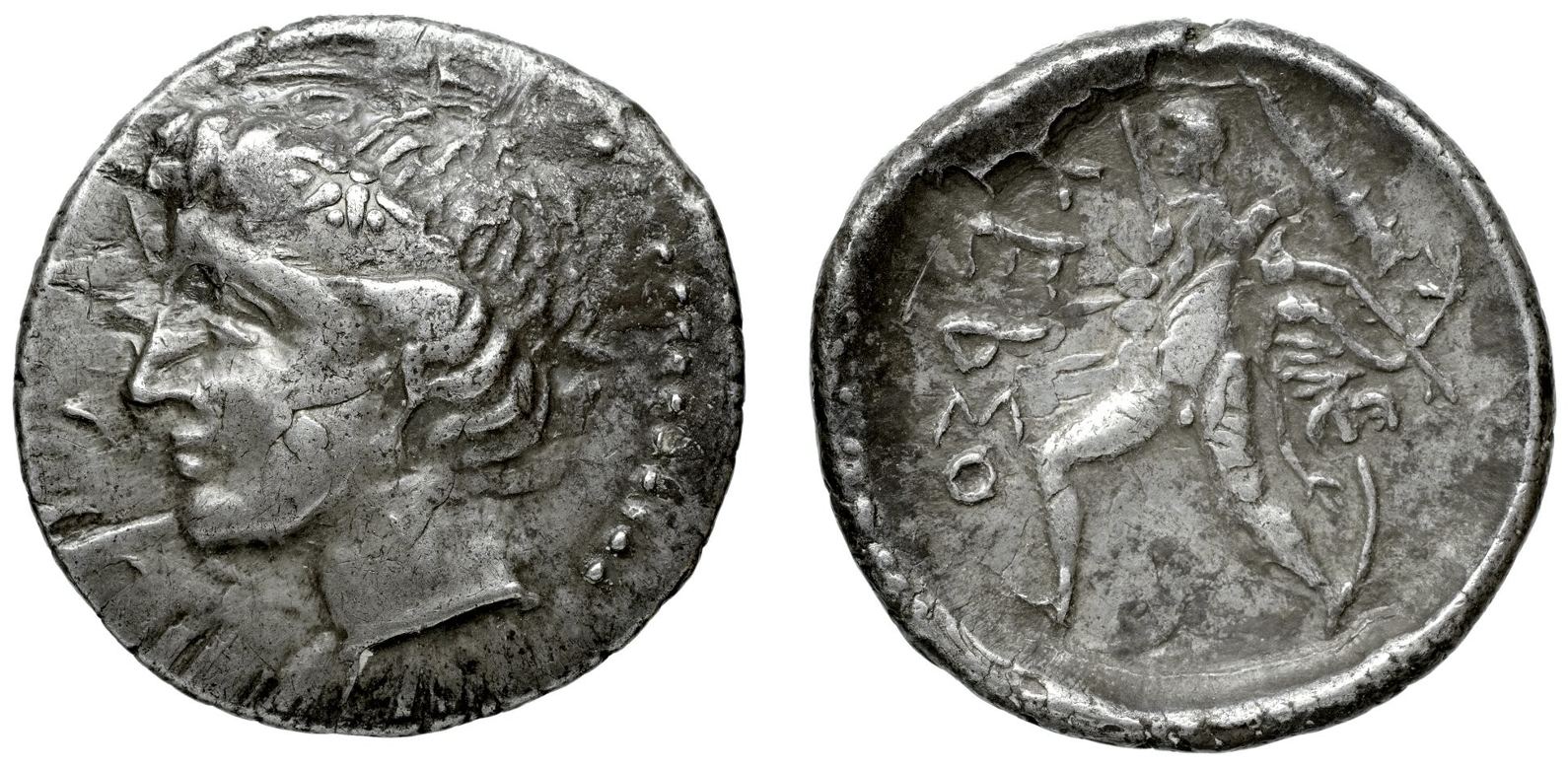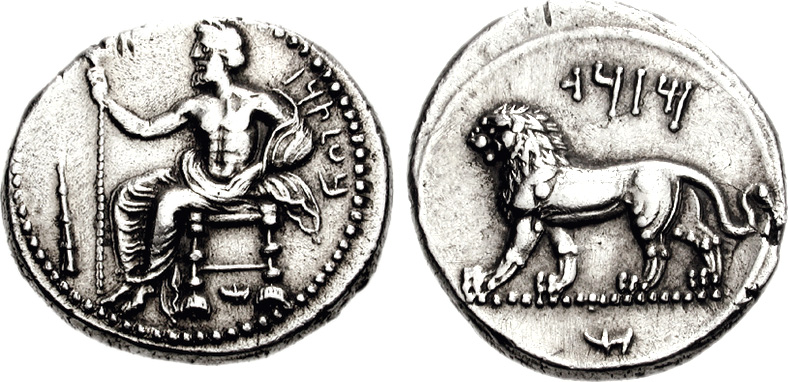330 BCE - 270 BCE | ΧΕΡΣΟ
Overstriking coin
SO 1491 - Chersonesus (AR didrachm) over Myriandrus.png
[1]
Overstruck variety
Myriandrus_lion_Baaltars.jpeg
[2]
Description
| ObverseInscription or printing placed on the obverse.:
|
Female head (Britomartis?) left. Border of dots.
|
ReverseInscription or printing placed on the reverse.:
|
ΧΕΡΣΟ (Greek) Herakles walking left, naked, holding Nemean scalp and club.
|
Mint and issuing power
| MintIdentifies the place of manufacture or issue of a numismatic object.:
|
Chersonesus (Crete)
|
Ancient regionAncient region.
|
Crete
|
Modern countryModern country: Greece
|
AuthorityIdentifies the issuing power. The authority can be "pretended" when the name or the portrait of X is on the coin but he/she was not the issuing power. It can also be "uncertain" when there is no mention of X on the coin but he/she was the issuing power according to the historical sources:
|
|
Chronology
| FromIdentifies the initial date in a range assigned in a numismatic context. 330 BCE toIdentifies the final date in a range assigned in a numismatic context.. 270 BCE
|
Hellenistic 323-30 BC  periodTime period of the numismatic object. periodTime period of the numismatic object.
|
Physical description
MetalThe physical material (usually metal) from which an object is made.: Silver 
|
WeightWeight of the numismatic object (in grams). in grams: 10.6110.61 g <br />10,610 mg <br />
|
DenominationTerm indicating the value of a numismatic object. Examples: tetradrachm, chalkous, denarius.: stater 
|
AxisDescribes the directional relationship between the obverse and reverse of a numismatic object.: 1212 mm <br />1.2 cm <br />
|
|
|
StandardStandard.: Aeginetic
|
References
| Coin referenceReference of the Coin:
|
Le Rider 1960, p. 8, n° 2, pl. 1 (https://catalogue.bnf.fr/ark:/12148/cb418137465)
|
Coin series referenceReference to coin series study:
|
Svoronos 18901Svoronos 1890, 6, Babelon 1901-19322Babelon 1901-1932, Tome 1, pl. CXIV. n° 16, Le Rider 19603Le Rider 1960, p. 8, n° 2, pl. 1, Le Rider 19664Le Rider 1966, pl. XXVII n° 25
|
| Coin series web referenceCoin series web references:
|
|
Description
| ObverseInscription or printing placed on the obverse.:
|
Baaltars seated left, holding lotus tipped sceptre in right hand, club to left (visible: Baaltars seated)
|
ReverseInscription or printing placed on the reverse.:
|
Aramaic MZDY above (Aramaic) Lion standing left, Aramaic M in exergue (visible: lion walking left and star)
|
Mint and issuing power
Chronology
| FromIdentifies the initial date in a range assigned in a numismatic context. 361 BCE toIdentifies the final date in a range assigned in a numismatic context.. 332 BCE
|
Classical 480-323 BC  periodTime period of the numismatic object. periodTime period of the numismatic object.
|
Physical description
| DenominationTerm indicating the value of a numismatic object. Examples: tetradrachm, chalkous, denarius. ᵖ:
|
double siglos 
|
StandardStandard. ᵖ:
|
Persic
|
References
References
- ^ Svoronos, Ioannes N. (1890), Numismatique de Crète ancienne, accompagnée de l'histoire, la géographie et la mythologie de l'île. Première partie, description des monnaies, 2 vol., Macon, Impr. Protat frères.
- ^ Babelon, Ernest (1901-1932), Traité des monnaies grecques et romaines, Paris, E. Leroux
- ^ Le Rider, Georges (1960), "Monnaies grecques acquises par le Cabinet des Médailles en 1959", Revue Numismatique 6 (3), p. 7-35, pl. 1-3.
- ^ Le Rider, Georges (1966), Monnaies crétoises du Ve au Ier siècle av. J.-C., Paris, Geuthner, 345 p. and 42 pl.
- ^ Newell, Edward T. (1919), "Myriandros - Alexandria Kat'Isson", AJN 53 (2), p. 1-42, pl. 1-2.

